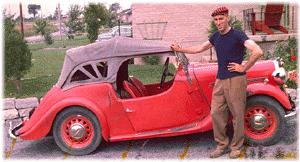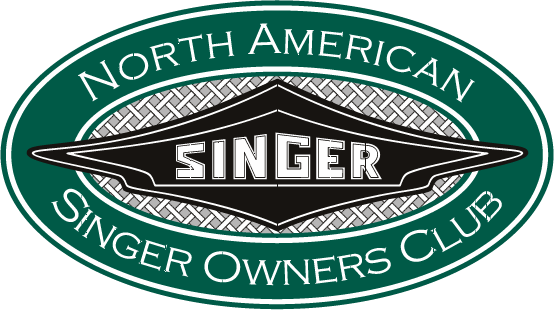9 Roadster
 The Singer Nine Roadster was introduced in 1939, and although technically not a post war model, it was the basis for the post war model line-up. It represented an attempt by Singer Motors to break away from its traditional product line of out and out racers and sedate family saloons to approach a new and specialized market niche.
The Singer Nine Roadster was introduced in 1939, and although technically not a post war model, it was the basis for the post war model line-up. It represented an attempt by Singer Motors to break away from its traditional product line of out and out racers and sedate family saloons to approach a new and specialized market niche.
The new Nine was neither a placid saloon, nor a sports car in either the trials or long distance road racing traditions, but it was of a sporting nature, with plenty of power, lively performance and attractive lines. In the Singer tradition, it also represented good value for the money as a spacious, four seater sporting tourer priced at £169.
The Nine was a very different car from the Sports and Le Mans Nines of the earlier thirties. Its chassis and engine, with an overhead cam and three bearing crankshaft, were largely borrowed from the Singer Bantam. Modifications to the engine included a quick-lift camshaft , slightly altered timing, a small increase in the compression ratio and a newly designed, high efficiency hot spot manifold to give the engine more pep. A single S.U. downdraft carburetor was fitted as standard.
With an output of 1074 cc’s and 36 b.h.p at 5,000 r.p.m., combined with a three speed gearbox and rear axle ratio of 5.43:1, the roadster obtained a maximum speed of 65 m.p.h. and was capable of nearly forty m.p.h. in 2nd gear.
The new Roadster had an instant appeal to enthusiasts. While it was well suited to the day to day grind of driving, its comfort and space made it entirely suitable for longer distance weekend jaunts.
For the 1940 model year the Roadster remained largely unchanged with the exception of certain items of useful and attractive extra equipment that were now available to the customer. These included a new tonneau that covered all four seats, which could be partially unzipped to allow the driver to drive, sliding glass sidescreens, rather than the traditional celluloid sidecurtains, a specially designed Moroccan leather suitcase fitted to the luggage compartment, twin aero screens for minimum protection when the wind screen was lowered flat and a chromium front bumper bar. Lastly, provided not as an extra, but as a standard item, Singer resumed its former practice of the thirties of providing an arrangement of tools, each with its own clip, on a platform under the bonnet.
Production of the Roadster was suspended after 1940 for the duration of World War II, and the Roadster was re-introduced essentially as is in 1946. The Autocar magazine wrote “it will be good news to many enthusasts that the Singer Nine Roadster has come back into production, for this light four seater open and all-weather car has won many friends by reason of its reliability and snappy performance”.
While no major modifications were introduced, there were several improvements in details. For example, an extre three inches of room in the seating compartment was gained by moving the engine further forward on the frame. As an added benefit, this also tended to improve the handling. The steering was modified by moving the steering box to the front end of the frame, in order to prevent the constant up and down movement of the front axle from affecting the steering. Lastly, Singer turned its attention to reducing vibration throughout the chassis. The tail end of the gear box was mounted on a rubber pad, rubber bushes were now used for the spring eyes and shackles, not only reducing vibration, but also eliminating a lubrication point. Similarly, bushes were used to isolate the exhaust pipe and muffler from the chassis.
A member of The Autocar technical staff summed up his impressions of the newly re-introduced Roadster as follows: “The steering is light and quick and gives that accuracy which the sports car driver needs. A good power output, together with a light weight, makes the car a definitely brisk performer, and the engine is not only lively, but also smooth running and mechanically pleasant. Altogether, it is a decidedly attractive open road style of car”.
The Roadster was now priced at £335 plus £93 purchase tax for a total of £428.
9 Roadster Specs
Engine
Four cylinder, 60 mm. by 95 mm. = 1,074 c.c.Treasury rating, 8.93 h.p.Overhead valves with overhead camshaftThree bearing counterbalanced crankshaftSteel connecting rodsSubmerged pump oil feed with internal and external bypass filtersAluminum alloy pistons12 volt coil ignition with automatic advanceSingle S.U. downdraft carburatorThermosyphon water circulation
Gearbox and TransmissionDry single-plate clutch with cushioned centreThree speed gear box with ratios 5.43, 9.9 and 18.08 to 1Synchromesh on second and third gearsNeedle-bearing open propeller shaftSpiral bevel final drive in pressed steel rear axle caseSemi-floating shafts
Wheels and Brakes16 inch pressed steel easy-clean wheels5.00 X 16 inch tiresGirling mechanical
SteeringBurman worm and nut
SuspensionHalf elliptic springs front and rearArmstrong double-acting hydraulic shock absorbers
Main DimensionsWheelbase 7 ft. 7 ins.Track 3ft 9 inOverall length 12 ft 5 3/4 inWidth 4 ft 7 3/4 inHeight 4 ft 8 inTurning circle 34 ftGround clearance 6 inWeight 15 1/2 cwt
Price
£169 (pre-war)£335 plus £93 purchase tax (post-war)
